There was
no hint of shade. Glittering piles of grey-white sand, the result of
wind and rain-eroded micaceous rock from the surrounding mountains,
carpeted the valley floor and the high-noon sun mercilessly reflected
off the desolate platinum landscape. My pack was growing heavier by the
moment and I felt my feet swelling inside my hiking boots, pressing
corns against the rough leather. I winced with each step and tried to
focus on where I planted my feet so as not to twist an ankle on the
loose rocks that littered the trail.
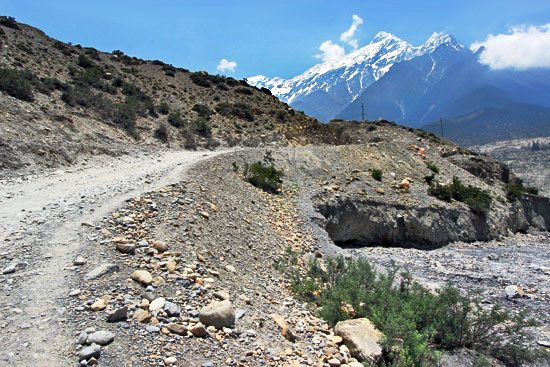
Sere landscape on the Marpha to Jomsom trek, the driest area in all of Nepal
I have come to the Jomsom area to prove something. After injuring my
knee in Mexico in 2010 my body started giving me fits. My left hip, knee
and lower back ached constantly and I had to cancel my plans to trek
the Annapurna Circuit in Nepal later that same year. Though I fought it
with every fiber of my being, gradually I accepted that my trekking days
were over.
Earlier this year I had to return to the U.S. for three and a half
months. It almost killed me. With no access to the affordable organic,
fresh, seasonal food that is abundant overseas, I began eating
unhealthily and gained 15 pounds. My
Yoga
and meditation practice faltered and I felt unhappy and stuck. Finally,
I concluded the business that was keeping me Stateside and rejoiced. I
was free again to hit the road. I headed for
Pokhara, Nepal to pursue my Yoga, meditation, and
Buddhism
practices with renewed vigor. Within a month I dropped all the weight I
had gained and my knee and hip were behaving nicely. I began to wonder
if perhaps my trekking days were not done.
The Jomsom area has always been the last leg of the 14-17 day
Annapurna Circuit, a trek through the magnificent Annapurna Himalaya
Mountains that was until recently only accessible on foot. Since I had
previously had to forego this trek I was delighted to learn that roads
had been put through to the various high mountain towns in the area. I
booked a flight to Jomsom and planned a route that would let me choose
between buses, jeeps, and trekking.
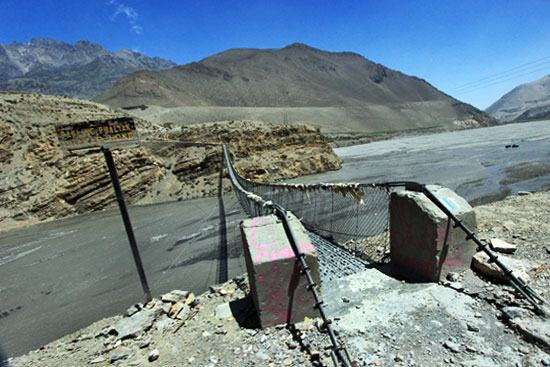
Foot bridge across the Kali Gandaki River on the route between Jomsom and Kagbeni
On the day I arrived I seriously considered doing the two hour trek
from Jomsom to Kagbeni, but by the time I had walked 20 minutes from the
airport to the jeep stand in Old Jomsom, my shoulders were aching. I
gratefully hefted my pack, loaded with camera, three lenses, tripod,
laptop and other ancillary equipment, into a waiting 4-wheel drive jeep.
Once I was in Kagbeni I dumped the large backpack, broke out my
daypack, and spent the next two days hiking nearby trails, adjusting to
the high altitude and the incessant winds that scream through the valley
every afternoon.

Looking back on Kagbeni during a day trek to Eklibhatti
After a couple of days of acclimatization I took a side trip to
Muktinath, site of an ancient temple that is one of holiest in the world
to both Hindus and Buddhists. Worried about the 14,000 foot elevation, I
opted for the jeep again, since I am prone to altitude sickness. Still,
I had to climb the steps to the mountaintop temple and come back down.
Again, no ill effects. I felt my confidence growing.
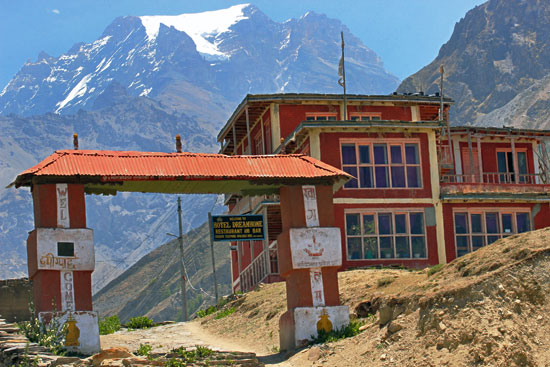
Gateway to Muktinath, home to a high mountain temple that is holy to Hindu and Buddhists alike
Back in Jomsom I hopped aboard a rattletrap bus to Marpha, apple
growing capital of Nepal. I had heard it was a mostly flat 1.5 hour walk
between the two villages but wasn’t quite ready to make the attempt
with fully loaded pack. I pulled aside my window curtain in order to see
the passing landscape but everyone else seemed content to leave their
curtains drawn. We stopped briefly in front of a tea shop where a
sun-faded sign announced we were in the village of Syang; beyond that
lay mile after mile of uninhabited, arid landscape. The bus jounced
along a rough bouldered track, at one point crossing a raging river in
the middle of a waterfall. Suddenly, through the front windshield of the
bus I glimpsed a sign: “Next village Tukche.” I yelled at the
conductor; Tukche was 30 minutes further down the mountain from Marpha.
The bus ground to a halt, spit me out, and I trudged back up the hill.
If I wasn’t willing test my abilities, it seemed the universe was going
to arrange it for me.
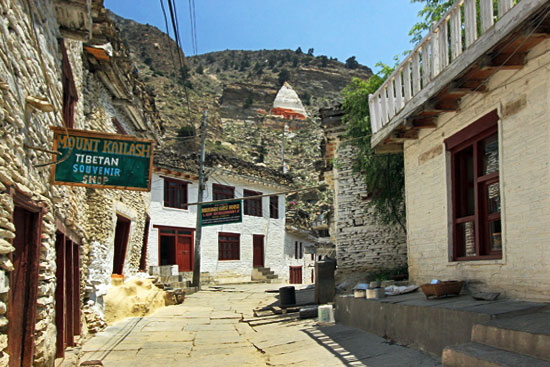
In
Marpha, the apple growing capital of Nepal, houses are constructed of
local stone, fitted together without benefit of mud or mortar
After three lovely, relaxing days in Marpha, I was finally ready to
trek rather than take the bus back to Jomsom. Just outside of town I
tackled my first obstacle: the waterfall that the bus had breezed
through. Rather than jump from boulder to boulder I spied a rough-hewn
wooden footbridge in the distance, so I took a shortcut through a
farmer’s field and crossed using three huge wooden beams that had been
wired together over the stream. The dirt track meandered for miles
through a vast, barren landscape where the muddy waters of the Kali
Gandaki River were virtually indistinguishable from the monotone earth.
Winds roared down from the mountains with a strength that nearly blew me
over each time I crested a hill.
Finally, the village of Syang came into view and I diverted onto a
smaller path leading down into the town, grateful for shelter provided
by old stone houses with multi-color wooden doors. As I left Syang
behind, the wind blew grit into my eyes and the straps of my backpack
dug deeper into my aching shoulders. I crested a low hill, desperate to
see Jomsom, but before me lay more rock-strewn valley, carved by
rivulets of gushing water, beyond which the trail ascended steeply. At
the top of the long rise I stopped to catch my breath, wondering how
much further I had to go. What was supposed to be a 1.5 hour trek had
already taken two hours. Groaning, I readjusted my pack and trudged
around a sweeping curve, where a deep valley opened up before me. On a
distant ridge was a beautiful sight: Jomsom.
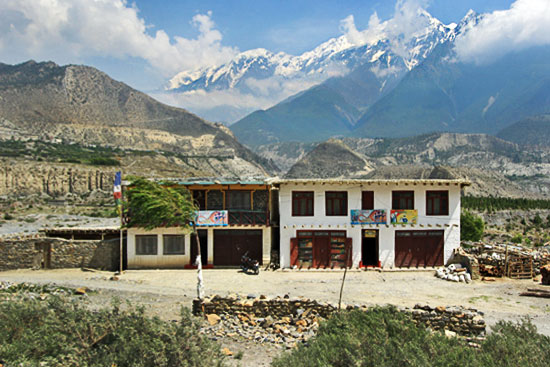
I
took a well earned rest at this local tea house, where I stopped to
rest and write this story...little did I know that I was only 10 minutes
away from Jomsom
Slowly, concentrating on every step, I headed down. The glaring sun
and choking dust kicked up by the wind were taking their toll and I
wondered if I could make it the rest of the way. Down in the valley I
looked up when a bus rattled past me and almost shed tears when I saw a
tea shop just steps away. An hour later, having downed two cups of honey
lemon ginger tea and rested my weary back and feet, I was good as new.
It was still one last uphill push to Jomsom but I knew I could make it.
Two and a half hours was not a long trek, but it was a start. Perhaps my
trekking days are not over after all.







No comments:
Post a Comment